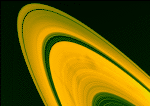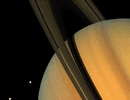
Saturn is the sixth planet from the Sun and the second largest:orbit: 1,429,400,000 km (9.54 AU) from Sun
diameter: 120,536 km (equatorial)
mass: 5.68e26 kgIn Roman mythology, Saturn is the god of agriculture. The associated Greek god, Cronus, was the son of Uranus and Gaia and the father of Zeus (Jupiter). Saturn is the root of the English word "Saturday" (see Appendix 4).
Saturn has been known since prehistoric times. Galileo was the first to observe it with a telescope in 1610; he noted its odd appearance but was confused by it. Early observations of Saturn were complicated by the fact that the Earth passes through the plane of Saturn's rings every few years as Saturn moves in its orbit. A low resolution image of Saturn therefore changes drastically. It was not until 1659 that Christiaan Huygens correctly inferred the geometry of the rings. Saturn's rings remained unique in the known solar system until 1977 when very faint rings were discovered around Uranus and shortly thereafter around Jupiter and Neptune).
Saturn was first visited by Pioneer 11 in 1979 and later by Voyager 1 and Voyager 2. Cassini, now on its way, will arrive in 2004.
Saturn is the least dense of the planets; its specific gravity (0.7) is less than that of water.
Like Jupiter, Saturn is about 75% hydrogen and 25% helium with traces of water, methane, ammonia and "rock", similar to the composition of the primordial Solar Nebula from which the solar system was formed.
Saturn's interior is similar to Jupiter's consisting of a rocky core, a liquid metallic hydrogen layer and a molecular hydrogen layer. Traces of various ices are also present.
Two prominent rings (A and B) and one faint ring (C) can be seen from the Earth. The gap between the A and B rings is known as the Cassini division. The much fainter gap in the outer part of the A ringis known as the Encke Division.
Though they look continuous from the Earth, the rings are actually composed of innumerable small particles each in an independent orbit. They range in size from a centimeter or so to several meters. A few kilometer-sized objects are also likely.
Saturn's rings are extraordinarily thin: though they're 250,000 km or more in diameter they're no more than 1.5 kilometers thick. Despite their impressive appearance, there's really very little material in the rings -- if the rings were compressed into a single body it would be no more than 100 km across.
The ring particles seem to be composed primarily of water ice, but they may also include rocky particles with icy coatings.
Voyager confirmed the existence of puzzling radial inhomogeneities in the rings called "spokes" which were first reported by amateur astronomers (left). Their nature remains a mystery, but may have something to do with Saturn's magnetic field.
Saturn's outermost ring, the F-ring, is a complex structure made up of several smaller rings along which "knots" are visible. Scientists speculate that the knots may be clumps of ring material, or mini moons. The strange braided appearance visible in the Voyager 1 images (right) is not seen in the Voyager 2 images perhaps because Voyager 2 imaged regions where the component rings are roughly parallel.
The origin of the rings of Saturn (and the other jovian planets) is unknown. Though they may have had rings since their formation, the ring systems are not stable and must be regenerated by ongoing processes, probably the breakup of larger satellites.
Like the other jovian planets, Saturn has a significant magnetic field.
When it is in the nighttime sky, Saturn is easily visible to the unaided eye. Though it is not nearly as bright as Jupiter, it is easy to identify as a planet because it doesn't "twinkle" like the stars do. The rings and the larger satellites are visible with a small astronomical telescope.
Back Home